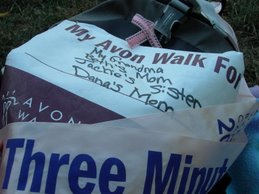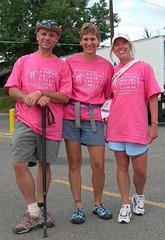
How to tell if a pink-ribbon product really helps breast cancer efforts
Tuesday, October 10, 2006
By Tara Parker-Pope, The Wall Street Journal
Store shelves are filling up with pink products tied to October's Breast Cancer Awareness month, but shoppers need to do their homework to be sure their green is really going to the right cause.
There is a seemingly endless variety of pink products on offer these days. The options range from food items -- pink M&Ms and Tic Tacs are popular -- to home appliances such as a pink KitchenAid mixer or a pink Dyson vacuum cleaner. Many products also carry the ubiquitous pink-ribbon logo that has become a universal symbol of breast-cancer awareness. Shoppers can choose from pink-ribbon slippers, towels, bedding, pajamas and jewelry, among other items.
But buyers need to look beyond the pink to be sure a product supports a legitimate breast-cancer group. Anybody can use the pink-ribbon logo, so it's important to read tags, boxes and fine print to find out what group is being supported and how much money it is getting from your purchase. Sometimes the money goes directly to breast-cancer research, while other purchases may support free mammograms for low-income women or simply "breast-cancer awareness."
Most major breast-cancer groups have strict requirements for disclosing how much of a pink product goes to charity. Consumers should look for labels and boxes that state what organization benefits and how much of the purchase price goes to it. Some products give only a vague description, promising that a "portion" of the proceeds supports breast-cancer research.
"Our rule is that a company must disclose whatever their donation is -- if they aren't willing to disclose it, they won't be accepted as a partner," says Robbie Finke, director of marketing for the
Breast Cancer Research Foundation, which lists all its pink products and the contribution on its Web site, www.bcrfcure.org. Some pink purchases clearly go further than others. Each sale of $60 Karey Kyle Rose Quartz earrings generates $40, or 67 percent of the purchase price, for the group BreastCancer.org. Spend $1,950 on a Van Cleef & Arpels pendant, and $1,000, or 51 percent of the price, goes to the Breast Cancer Research Foundation. KitchenAid offers a variety of Cook for the Cure products that benefit the Susan G. Komen Breast Cancer Foundation (www.komen.org). The company donates $50, or about 17 percent of the purchase price, from sales of its pink Artisan Stand Mixer. Meanwhile, 50 cents from the purchase of a $13 pair of pink-ribbon Meshmellows slippers -- or about 4 percent of the purchase price -- goes to the National Breast Cancer Foundation (www.nationalbreastcancer.org).
Sometimes simply buying a pink product doesn't guarantee money will be given to breast-cancer causes. The shopper has to take an extra step, such as mailing in product lids or labels or registering online to generate income for charity. For instance, Yoplait products with pink lids support the Komen Foundation -- but only if you mail them in. Specially marked bags of Sun Chips carry a pink ribbon, but the 25-cent-per-bag donation to Komen is triggered only when the shopper goes to a Web site and enters a special code. Viva paper towels will donate $100,000 to the Breast Cancer Research Foundation, but if shoppers redeem a special coupon the company will donate an additional 10 cents, up to a total $200,000 donation.
Shoppers also need to decide what type of breast-cancer projects they support, because groups with pink products have different missions. The best way is to check a group's Web site. The Breast Cancer Research Foundation last year spent 89 percent of the $27 million it raised on research grants for breast-cancer prevention and treatment. The Komen Foundation spends most of its funds on breast-cancer education, awareness and community programs, such as free mammograms, but allocates about 40 percent to breast-cancer research. Products that support Breastcancer.org help support the group's mission to provide women the most up-to-date medical information about breast cancer. Products like a pink Gund plush bear support LIFE, which stands for LPGA Pros in the Fight to Eradicate breast cancer, a group that focuses on education and awareness about the risks of breast cancer to young women. Meanwhile, CancerCare, which receives support from the sale of pink Tic Tacs and pink Women for Hope bracelets (www.womenforhope.com), uses money it raises for support services for people affected by cancer.
Last year, pink products accounted for $35 million of the Komen Foundation's $200 million in annual revenue. Cindy Schneible, vice president of resource development for Komen, says the pink products do more than raise money for research -- they also raise awareness among people who might not otherwise think about breast cancer. "Our mission is to engage people where they live, work and play," says Ms. Schneible.







